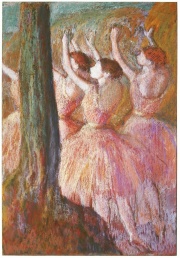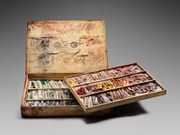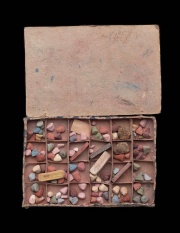Difference between revisions of "Pastel"
m (Text replace - "\[http:\/\/cameo\.mfa\.org\/materials\/fullrecord\.asp\?name=([^\s]+)\s(.*)\]" to "$2") |
|||
| (2 intermediate revisions by the same user not shown) | |||
| Line 1: | Line 1: | ||
| − | [[File:20.164-SC24375.jpg|thumb|'' | + | [[File:20.164-SC24375.jpg|thumb|Degas 'Dancers in Rose'<br>MFA# 20.164]] |
== Description == | == Description == | ||
| − | + | [[File:22.604-SC74236.jpg|thumb|Monet 'View of Sea and Sunset', MFA# 22.604]] | |
A soft, blendable, pigmented drawing stick. Pastel chalks or crayons were first documented by Da Vinci in 1495 with a reference to their use by Jean Perreal in France (Shelley 1999). They became very popular for portraiture in the mid-18th century and were revived in the late 19th century. Pastel crayons are made with a finely ground pigments mixed with a small amount of a water-based binder, such as gum tragacanth or, from the mid-20th century, methyl cellulose. Many pastels contain pure pigments producing intense, deep colors; lighter colors are diluted with an inert filler (chalk, gypsum, talc, kaolin, etc.). Pastels produce a powdery, easily smudged drawing. To minimize smudging, some pastels are 'fixed' or secured with an aerosol-sprayed, thin layer of varnish called a fixative. Fixatives, however, tend change the optical appearance of the pastels. | A soft, blendable, pigmented drawing stick. Pastel chalks or crayons were first documented by Da Vinci in 1495 with a reference to their use by Jean Perreal in France (Shelley 1999). They became very popular for portraiture in the mid-18th century and were revived in the late 19th century. Pastel crayons are made with a finely ground pigments mixed with a small amount of a water-based binder, such as gum tragacanth or, from the mid-20th century, methyl cellulose. Many pastels contain pure pigments producing intense, deep colors; lighter colors are diluted with an inert filler (chalk, gypsum, talc, kaolin, etc.). Pastels produce a powdery, easily smudged drawing. To minimize smudging, some pastels are 'fixed' or secured with an aerosol-sprayed, thin layer of varnish called a fixative. Fixatives, however, tend change the optical appearance of the pastels. | ||
See also [[oil%20pastel|oil pastel]]. | See also [[oil%20pastel|oil pastel]]. | ||
| − | + | [[File:MFA199983 Pastel.jpg|thumb|Mary Cassatt pastel box<br>MFA# 1999.83]] | |
| − | [[File: | + | [[File:99.664.114-SC33419.jpg|thumb|Pastel box (1810s)<br>MFA# 99.664.114]] |
== Synonyms and Related Terms == | == Synonyms and Related Terms == | ||
pastels (pl.); pastel (Esp., Fr., Port.); colored chalk; French chalk; pastel crayon | pastels (pl.); pastel (Esp., Fr., Port.); colored chalk; French chalk; pastel crayon | ||
| − | == | + | == Risks == |
| + | |||
| + | * Some organic colorants used from the 19th c. on may not be lightfast. | ||
| + | == Physical and Chemical Properties == | ||
Binder is water soluble. | Binder is water soluble. | ||
| − | |||
| − | |||
| − | |||
| − | |||
| − | |||
| − | |||
| − | |||
| − | |||
| − | |||
== Comparisons == | == Comparisons == | ||
[[media:download_file_546.pdf|Websites of pastel, pencil and marker manufacturers]] | [[media:download_file_546.pdf|Websites of pastel, pencil and marker manufacturers]] | ||
| − | |||
| − | |||
| − | |||
| − | |||
| − | |||
| − | |||
== Additional Images == | == Additional Images == | ||
| Line 40: | Line 28: | ||
File:Rembrant_pastels.jpg|Rembrandt pastels | File:Rembrant_pastels.jpg|Rembrandt pastels | ||
File:pastel pencil.jpg|Pastel pencil | File:pastel pencil.jpg|Pastel pencil | ||
| − | File:pastel pencil2 100X.jpg|Pastel pencil | + | File:pastel pencil2 100X.jpg|Pastel pencil at 100x |
</gallery> | </gallery> | ||
| + | == Resources and Citations == | ||
| + | |||
| + | * M.Shelley, "Pastel" in Media and Techniques of Works of Art on Paper, New York University Conservation Center of the Institute of Fine Arts, New York, 1999. | ||
| − | + | * G.Monnier, "Pastel", ''The Dictionary of Art'', Grove's Dictionaries Inc., New York, 1996. | |
* R. J. Gettens, G.L. Stout, ''Painting Materials, A Short Encyclopaedia'', Dover Publications, New York, 1966 Comment: p. 47 | * R. J. Gettens, G.L. Stout, ''Painting Materials, A Short Encyclopaedia'', Dover Publications, New York, 1966 Comment: p. 47 | ||
Latest revision as of 09:18, 27 September 2022
Description
A soft, blendable, pigmented drawing stick. Pastel chalks or crayons were first documented by Da Vinci in 1495 with a reference to their use by Jean Perreal in France (Shelley 1999). They became very popular for portraiture in the mid-18th century and were revived in the late 19th century. Pastel crayons are made with a finely ground pigments mixed with a small amount of a water-based binder, such as gum tragacanth or, from the mid-20th century, methyl cellulose. Many pastels contain pure pigments producing intense, deep colors; lighter colors are diluted with an inert filler (chalk, gypsum, talc, kaolin, etc.). Pastels produce a powdery, easily smudged drawing. To minimize smudging, some pastels are 'fixed' or secured with an aerosol-sprayed, thin layer of varnish called a fixative. Fixatives, however, tend change the optical appearance of the pastels.
See also Oil pastel.
Synonyms and Related Terms
pastels (pl.); pastel (Esp., Fr., Port.); colored chalk; French chalk; pastel crayon
Risks
- Some organic colorants used from the 19th c. on may not be lightfast.
Physical and Chemical Properties
Binder is water soluble.
Comparisons
Websites of pastel, pencil and marker manufacturers
Additional Images
Resources and Citations
- M.Shelley, "Pastel" in Media and Techniques of Works of Art on Paper, New York University Conservation Center of the Institute of Fine Arts, New York, 1999.
- G.Monnier, "Pastel", The Dictionary of Art, Grove's Dictionaries Inc., New York, 1996.
- R. J. Gettens, G.L. Stout, Painting Materials, A Short Encyclopaedia, Dover Publications, New York, 1966 Comment: p. 47
- Reed Kay, The Painter's Guide To Studio Methods and Materials, Prentice-Hall, Inc., Englewood Cliffs, NJ, 1983
- Ralph Mayer, A Dictionary of Art Terms and Techniques, Harper and Row Publishers, New York, 1969 (also 1945 printing)







